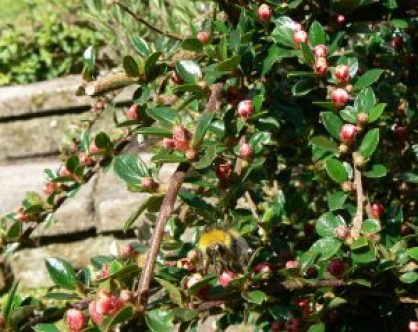News of a busy Cotoneaster in Willen
One of the joys of late spring in our garden is the blooming of the Cotoneaster horizontalis. This plant produces small pink flowers which, unless you inspect closely just seem to be buds that never open.
Even on a day like today, when the air temperature is around 10 C, the plant is alive with bees. On a hot day, their humming is almost louder than the traffic on the M1. All cotoneasters are good for nectar but this species is the best. This plant is not more than 2 feet in height but about 5 feet across and, in a quick count today, there were at least two dozen bees on it. The majority were the workers of the tree bumble bee, Bombus hypnorum and the spring bumble bee, Bombus pratorem. Also present, a single honey bee – well it is a cold day.
The small flowers of the plant are well suited to the short tongued bumble bees. It is well known that bees do not bother to visit a flower that has been recently visited by another individual bee. I read in Dave Goulson’s book, A Sting in the Tail, that it has been shown, by clever research which involved washing the feet of bees, that each bee leaves a smelly footprint on the flower which can be detected by another bee. The smell declines over time so the insect can determine when the flower was last visited. Different plants refill their nectaries at different rates, borage being a notable plant that refills very quickly, in about two minutes, compared with comfrey which takes upwards of forty minutes. So out I go with my stopwatch and observe a single flower. I took three readings all under ten minutes, the average time between visits being 6 minutes. Considering that this single plant must be covered in thousands of flowers, it explains why it is such a good nectar source.
Our plant is one of a large family of cotoneasters which originate in India, Tibet or China. Horizontalis is the one that is most recognisable and has acquired a common name, the Fishbone or Herringbone cotoneaster. Originally found in China, it was brought to the west in the 19th century by that saviour of deer, Pere David. Considered by some to be too invasive, our plant arrived by chance about 20 years ago and established itself on the edge of our north-facing patio where, apart from when we trip over it, it has become most welcome.
As the year progresses, other species make the most of this shrub. This week, when the song thrush chicks fledged, their parent took them right under the branches into its heart to hunt for snails. Throughout the rest of the year, the wren is most active in it and the dunnock uses it as a hidey hole to escape from the aggressive robin. We often see glimpses of bank voles rushing into cover under it and frogs and toads live under it as well. Occasionally, a grass snake makes an appearance. On one memorable occasion, many years ago, a mink appeared from under it.
Once the berries form in the autumn, it becomes of great interest to other species. In the past, this would have been blackbirds, thrushes, sometimes redwings in the depths of winter but these days, the resident wood pigeon gobbles them up quite early in the autumn, a bird so fat it seems to waddle.
Ann and Mark Strutton
May 2020


